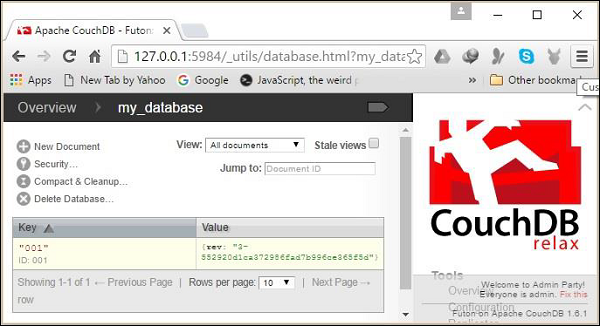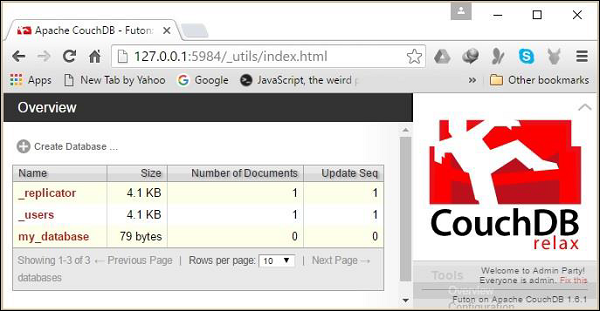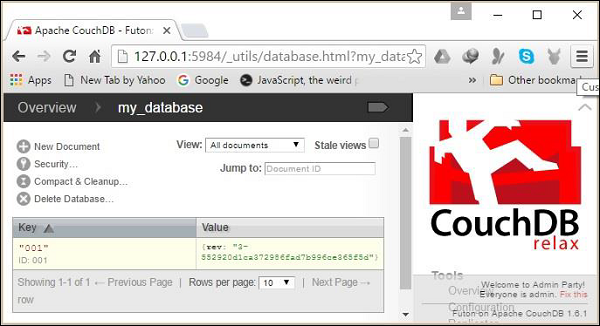Your cart is currently empty!
Category: pouchdb
-
Khóa học miễn phí PouchDB – Read Document nhận dự án làm có lương
PouchDB – Read Document
You can read/retrieve the contents of a document in PouchDB using the db.get() method.
Syntax
Following is the syntax of using the db.get() method of PouchDB. This method accepts the document id and an optional callback function.
db.get(document, callback)
Example
Following is an example of reading the contents of a document in PouchDB using the get() method.
//Requiring the package var PouchDB = require(''PouchDB''); //Creating the database object var db = new PouchDB(''my_database''); //Reading the contents of a Document db.get(''001'', function(err, doc) { if (err) { return console.log(err); } else { console.log(doc); } });Save the above code in a file with name Read_Document.js. Open the command prompt and execute the JavaScript file using node as shown below.
C:PouchDB_Examples >node Read_Document.js
This reads the contents of the given document that exists in the database named my_database which is stored locally. The following message gets displayed on the console.
{ name: ''Raju'', age: 23, designation: ''Designer'', _id: ''001'', _rev: ''1-ba7f6914ac80098e6f63d2bfb0391637'' }Reading a Document from a Remote Database
You can also read a document from the database that is stored remotely on the server (CouchDB).
To do so, instead of a database name, you need to pass the path to the database in CouchDB, which contains the document that is to be read.
Example
Suppose, there is a database named my_database in the CouchDB server. Then, if you verify the list of databases in CouchDB using the URL http://127.0.0.1:5984/_utils/index.html you will get the following screenshot.

By clicking on the database named my_database you can see the following screenshot. Here, you can observe that this database contains a document with id 001.

Following is an example of reading the contents of the document having id as “001” that exists in a database named my_database, which is stored in the CouchDB server.
//Requiring the package var PouchDB = require(''PouchDB''); //Creating the database object var db = new PouchDB(''http://localhost:5984/my_database''); //Reading the contents of a document db.get(''001'', function(err, doc) { if (err) { return console.log(err); } else { console.log(doc); } });Save the above code in a file with the name Remote_Read_Document.js. Open the command prompt and execute the JavaScript file using node as shown below.
C:PouchDB_Examples >node Remote_Read_Document.js
This reads the contents of the given document that exists in the database named my_database which is stored in CouchDB. The following message is displayed on the console.
{ _id: ''001'', _rev: ''3-552920d1ca372986fad7b996ce365f5d'', name: ''Raju'', age: 23, designation: ''Designer'' }
Khóa học lập trình tại Toidayhoc vừa học vừa làm dự án vừa nhận lương: Khóa học lập trình nhận lương tại trung tâm Toidayhoc
Khóa học miễn phí PouchDB – Create Document nhận dự án làm có lương
PouchDB – Create Document
You can create a document in PouchDB using the db.put() method.
Syntax
Following is the syntax of using the db.put() method of PouchDB. You can store the document that is to be created in PouchDB, in a variable and pass as a parameter to this method. In addition, this method also accepts a callback (optional) function as a parameter.
db.put(document, callback)
Example
Following is an example of creating a document in PouchDB using the put() method. The document we create should be of JSON format, a set of key-value pairs separated by comma (,) and enclosed within curly braces ({}).
//Requiring the package
var PouchDB = require(''PouchDB'');
//Creating the database object
var db = new PouchDB(''my_database'');
//Preparing the document
doc = {
_id : ''001'',
name: ''Raju'',
age : 23,
designation : ''Designer''
}
//Inserting Document
db.put(doc, function(err, response) {
if (err) {
return console.log(err);
} else {
console.log("Document created Successfully");
}
});
Save the above code in a file with name Create_Document.js. Open the command prompt and execute the JavaScript file using node as shown below.
C:PouchDB_Examples >node Create_Document.js
This creates the given document in PouchDB database named my_database, which is stored locally, displaying the following message.
Document created Successfully
Inserting a Document in a Remote Database
You can also insert a document in the database that is stored remotely on the server (CouchDB).
To do so, instead of database name you need to pass the path to the database where you want to create documents in CouchDB.
Example
Suppose there is a database named my_database in the CouchDB server. Then, if you verify the list of databases in CouchDB using the URL http://127.0.0.1:5984/_utils/index.html you will get the following screenshot.

Now, if you click on the database named my_database, you will find an empty database as shown in the following screenshot.

Following is an example of inserting a document in a database named my_database that is saved in the CouchDB server.
//Requiring the package
var PouchDB = require(''PouchDB'');
//Creating the database object
var db = new PouchDB(''http://localhost:5984/my_database'');
//Preparing the document
doc = {
_id : ''001'',
name: ''Raju'',
age : 23,
designation : ''Designer''
}
//Inserting Document
db.put(doc, function(err, response) {
if (err) {
return console.log(err);
} else {
console.log("Document created Successfully");
}
});
Save the above code in a file with the name Remote_Create_Document.js. Open the command prompt and execute the JavaScript file using node as shown below.
C:PouchDB_Examples >node Remote_Create_Document.js
This creates the given document in PouchDB database named my_database which is stored in CouchDB, displaying the following message.
Document created Successfully
Verification
After executing the above program, if you visit the my_database again, you can observe the document created as shown in the following screenshot.

Khóa học lập trình tại Toidayhoc vừa học vừa làm dự án vừa nhận lương: Khóa học lập trình nhận lương tại trung tâm Toidayhoc